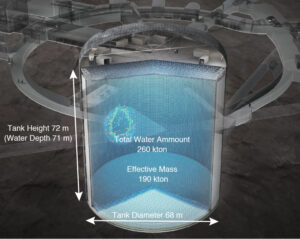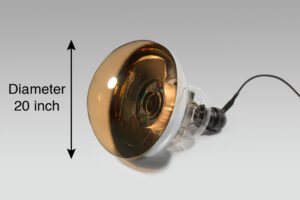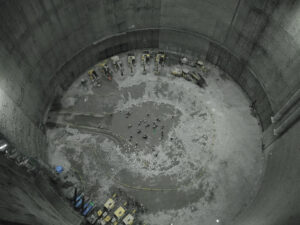Hyper-Kamiokande Cavern Excavation Completed
At the High Energy Physics Laboratory of Osaka Metropolitan University, we are making rapid progress in preparing for the Hyper-Kamiokande experiment, with the goal of beginning data collection in 2028. The Hyper-Kamiokande collaboration is an international research group hosted by the Institute for Cosmic Ray Research of the University of Tokyo and the High Energy Accelerator Research Organization (KEK), with Osaka Metropolitan University also serving as a core institution. As of July 2025, the collaboration includes around 640 researchers from 22 countries worldwide. A new Hyper-Kamiokande detector, with an effective volume approximately eight times larger than that of the Super-Kamiokande detector, is being constructed in the Kamioka mine in Hida City, Gifu Prefecture. This will be combined with an intense neutrino beam from J-PARC in Tokai Village, Ibaraki Prefecture, to achieve the following goals:
- Measure the difference in oscillation probabilities between neutrinos and antineutrinos to investigate CP violation in the neutrino sector and explore the mystery of why matter remains in the universe.
- Search for proton decay to test Grand Unified Theories (GUTs), which aim to unify the electroweak and strong forces.
- Detect neutrinos from supernova explosions to obtain crucial information about explosion mechanisms and the birth of black holes, as well as to clarify how stars formed and heavy elements were created in the evolution of the universe—thereby making significant advancements in neutrino astronomy.
Figure 1 shows a conceptual illustration of the completed Hyper-Kamiokande detector. It will be a massive cylindrical water tank, 68 meters in diameter and 72 meters in height, filled with 260,000 tons of ultrapure water produced by a water purification system. Approximately 20,000 new 50-cm-diameter photomultiplier tubes (Figure 2) will be installed on all interior walls. The enormous underground cavern to house the tank is being constructed 600 meters beneath the summit of Mt. Nijugo-yama in Kamioka. Excavation of the access tunnel leading to the cavern began in May 2021, and by June 2022, the center of the cavern’s ceiling dome was reached. Excavation of the dome began in November 2022, and a large space 69 meters in diameter and 21 meters in height was excavated using an arched structure to withstand the pressure of 600 meters of overlying rock. Over 600 anchor bolts were installed in the ceiling to stabilize the cavern walls. In October 2023, following the completion of the dome excavation, work began on the 73-meter-deep cylindrical section beneath it. To remove the excavated rock, a 70-meter-deep vertical shaft was first drilled at the center of the cylinder to connect the cavern with the lower-level approach tunnel. Rock blasted with explosives was dropped through this shaft and carried out by dump trucks. Anchor bolts were also systematically installed in the cylindrical walls for stability. During excavation, minor instability was detected in some wall sections, requiring additional reinforcement, which was promptly and safely carried out. As of June 2025, the full excavation of the cavern—measuring 69 meters in diameter and 94 meters in height—has been completed. This is now the largest artificially constructed underground space in the world. A ceremony to commemorate the completion of the excavation was held on June 28, with media coverage, and an open house for the public was held on June 29. Figures 3 and 4 show photographs of the cavern. Comparing the size of the construction machinery, such as excavators shown in the photos, gives a clear sense of the scale of this massive underground space. From this point forward, a reinforced water tank capable of withstanding high water pressure will be built by placing stainless steel plates layer by layer from the bottom up, inserting rebar between the plates and the rock, and pouring concrete. The stainless steel plates will be carefully welded to ensure there are no leaks. Once the tank is complete, photomultiplier tubes will be mounted on a structural frame on the floor, which will then be lifted step by step to install the tubes on the walls, floor, and ceiling. After this process, ultrapure water produced by the purification system will be gradually filled into the tank. It will take more than six months to fill, and during this time, the water will be continuously circulated between the tank and the purification system to increase purity. The system is designed so that precise observations can begin as soon as the tank is full. The start of observation is planned for June 2028.
- Hyper-Kamiokande Home Page
- Hyper-Kamiokande Excavation Movie (in Japanese)




